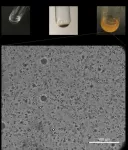(Press-News.org) DALLAS, May 13, 2021 -- Higher body mass index (BMI) in adolescence is associated with a significantly higher risk of first ischemic stroke in adults under age 50 regardless of whether they had Type 2 diabetes, according to new research published today in Stroke, a journal of the American Stroke Association, a division of the American Heart Association.
While rates of adolescent obesity and stroke among adults under the age of 50 years continue to rise around the world, the precise link between the two conditions is still not fully understood.
"Adults who survive stroke earlier in life face poor functional outcomes, which can lead to unemployment, depression and anxiety," said study co-author Gilad Twig, M.D., M.P.H., Ph.D., an associate professor in the Medical Corps of the Israel Defense Forces and the department of military medicine, Faculty of Medicine of The Hebrew University in Jerusalem, Israel. "The direct and indirect costs attributed to stroke prevention and care are high and expected to keep increasing since the rate of stroke continues to rise."
This study specifically analyzed adolescent BMI and first stroke before the age of 50 among 1.9 million men and women (ages 16 to 20; 58% men; 84% born in Israel) from two nationwide databases: the Israel Defense Forces and the Israeli National Stroke Registry. All the participants in the database had undergone one complete medical exam between 1985 and 2013.
Standard BMI groups are underweight (less than 5th percentile), low-normal BMI (5th to 49th percentile), high-normal BMI (50th to 84th percentile), overweight (85th to 94th percentile), and obese (greater than 95th percentile). Details on percentile BMI measures by gender are in the article.
During the follow-up period, for all 1.9 M participants between 2014 and 2018, researchers found:
Overall, 1,088 strokes occurred (921 ischemic strokes, 167 hemorrhagic strokes), and the average age at the time of the stroke was 41. Adolescent BMI was directly related to the risk of first ischemic stroke.
Compared to participants in the low-normal BMI group, adolescents who were in the overweight category had a 2-times higher stroke risk before the age of 50, and adolescents with obesity had a 3.4-times higher risk.
Even adolescents with BMIs in the high-normal range were more likely to have a stroke before age 50 compared to those in the low-normal BMI group.
After accounting for Type 2 diabetes, adolescents who were in either the overweight or obesity category still had a higher risk of stroke (1.6-times and 2.4-times, respectively) compared to people who had BMI values within the normal range.
Despite overweight and obesity during adolescence being a common problem, researchers were surprised to find that Type 2 diabetes did not explain the higher risk for ischemic stroke, which occurred even before the age of 30 in some cases. Current medical literature has shown that having a stroke early in life may lead to recurrent stroke, heart attack, long-term care and premature death, Twig noted.
"Our findings underscore the importance of effective treatment and prevention of high normal and excessively high BMI during adolescence," Twig said. "Our study is also the first to show that the risk of stroke associated with higher BMI values is the same for both men and women."
A major limitation of the study is that BMI data at follow-up were not available for all participants, which meant that researchers were unable to assess the contribution of obesity over time to stroke risk and to determine the independent risk of BMI during adolescence.
INFORMATION:
Co-authors are Aya Bardugo, M.D., M.Sc.; Boris Fishman, M.D., M.P.H.; Carmit Libruder, M.Sc.; David Tanne, M.D.; Amit Ram, R.N., M.P.H.; Yael Hershkovitz, M.Sc.; Inbar Zucker, M.D.; Ariel Furer, M.D.; Roy Gilon, M.D.; Gabriel Chodick, Ph.D.; Shmuel Tiasono, M.D., M.P.H.; Estela Derazne, M.Sc.; Dorit Tzur, M.B.A.; Amon Afek, M.D., M.H.A.; Orit Pinhas-Hamiel, M.D.; Cole Daniel Bendor, M.D.; Gal Yaniv, M.D., Ph.D.; and Ran Shmuel Rotem, Ph.D.
The study was funded by the Medical Corps of the Israel Defense Forces.
Additional Resources:
Multimedia is available on the right column of the release link: https://newsroom.heart.org/news/obesity-during-adolescence-linked-to-increased-risk-of-stroke-as-an-adult?preview=bd07c3666c0054b9ef1f4739a610fcfe
Statements and conclusions of studies published in the American Heart Association's scientific journals are solely those of the study authors and do not necessarily reflect the Association's policy or position. The Association makes no representation or guarantee as to their accuracy or reliability. The Association receives funding primarily from individuals; foundations and corporations (including pharmaceutical, device manufacturers and other companies) also make donations and fund specific Association programs and events. The Association has strict policies to prevent these relationships from influencing the science content. Revenues from pharmaceutical and biotech companies, device manufacturers and health insurance providers are available here, and the Association's overall financial information is available here.
About the American Stroke Association
The American Stroke Association is a relentless force for a world with fewer strokes and longer, healthier lives. We team with millions of volunteers and donors to ensure equitable health and stroke care in all communities. We work to prevent, treat and beat stroke by funding innovative research, fighting for the public's health, and providing lifesaving resources. The Dallas-based association was created in 1998 as a division of the American Heart Association. To learn more or to get involved, call 1-888-4STROKE or visit stroke.org. Follow us on Facebook and Twitter.
It's a tough time to be a shark. Pollution, industrialized fishing, and climate change threaten marine life, and the populations of many top ocean predators have declined in recent years. In addition to studying sharks in the wild, scientists working to save sharks rely on ones living in zoos and aquariums so that they can help build breeding programs and learn more about the conditions sharks need to thrive. One important way the scientists do that is by playing matchmakers to the sharks, pairing up individuals in ways that increase genetic diversity. In a new study in Scientific Reports, scientists undertook the largest-ever effort to artificially inseminate sharks.Their work resulted in 97 new baby sharks, ...
Wild orangutans are known for their ability to survive food shortages, but scientists have made a surprising finding that highlights the need to protect the habitat of these critically endangered primates, which face rapid habitat destruction and threats linked to climate change.
Scientists found that the muscle mass of orangutans on the island of Borneo in Southeast Asia was significantly lower when less fruit was available. That's remarkable because orangutans are thought to be especially good at storing and using fat for energy, according a Rutgers-led study in the journal Scientific Reports.
The findings highlight ...
All modern life is composed of cells, from single-celled bacteria to more complex organisms such as humans, which may contain billions or even trillions of cells, but how life came to be cellular remains uncertain. New research led by specially appointed assistant professor Tony Z. Jia at the Earth-Life Science Institute (ELSI) at Tokyo Institute of Technology, along with colleagues from around the world (Japan, Malaysia, France, Czech Republic, India and the USA), shows that simple chemical compounds known as hydroxy acids, which were likely common on primitive Earth, spontaneously link together ...
Scientists have begun the search for extraterrestrial life in the Solar System in earnest, but such life may be subtly or profoundly different from Earth-life, and methods based on detecting particular molecules as biosignatures may not apply to life with a different evolutionary history. A new study by a joint Japan/US-based team, led by researchers at the Earth-Life Science Institute (ELSI) at the Tokyo Institute of Technology, has developed a machine learning technique which assesses complex organic mixtures using mass spectrometry to reliably classify them as biological or abiological.
In season 1, episode 29 ("Operation: Annihilate!") of Star Trek, which aired in 1966, the human-Vulcan hybrid character ...
PULLMAN, Wash. - Rush hour will likely return when pandemic lockdowns lift, but a new study suggests that congestion pricing--policies that charge tolls for driving during peak hours--could not only cure traffic jams but also convince motorists it is safe to buy smaller, more efficient cars.
Researchers from Washington State University and the Brookings Institution studied a sample of nearly 300 households in the Seattle area over a six-year period, finding that the more congested their commutes, the more likely they would buy bigger cars which they perceive as safer and more ...
New research presented at this year's European Congress on Obesity (held online, 10-13 May) shows that the obesity drug semaglutide reduces appetite, food cravings and energy intake in people given a meal where they could eat as much as they liked. The study is by Dr Dorthe Skovgaard, Novo Nordisk A/S (the manufacturer of the drug), Søborg, Denmark, and colleagues.
Semaglutide, in the glucagon-like peptide-1 (GLP-1) analogue drug class, is currently available at the dose of 1.0 mg injected once weekly for the treatment of type 2 diabetes and is under development for chronic weight management at the dose ...
An early study of a new experimental drug to treat obesity known as cagrilintide shows that, when combined with semaglutide 2.4 mg, the combination leads to more weight loss than semaglutide 2.4 mg alone and is well tolerated. This phase 1 study, which was recently published in The Lancet will be presented at this year's European Congress on Obesity (held online, 10-13 May) by Dr Lone Enebo, Novo Nordisk A/S, Denmark, on behalf of her colleagues. Novo Nordisk A/S is the manufacturer of both drugs in this study.
Combining medications with different modes of action may provide more effective treatment options for people with obesity. Weekly injections of cagrilintide, ...
Two-thirds of California prisoners who were offered a COVID-19 vaccine accepted at least one dose, according to a new study by researchers at the Stanford University School of Medicine.
"We found that many incarcerated people in California prisons were willing to be vaccinated for COVID-19," said Elizabeth Chin, the lead author of the study and a PhD candidate in biomedical data science. "This is an encouraging sign for other states at an early stage of rolling out vaccination programs in their prisons and jails."
The researchers also found that nearly half of those who initially turned down a COVID-19 vaccine accepted it when it was offered to them again. The finding is an important indication that vaccine hesitancy is not necessarily fixed.
Two-thirds ...
The 1949 letter by the physicist and Nobel laureate discusses bees, birds and whether new physics principles could come from studying animal senses.
It's a position still being realised within physics to this day, with a growing body of research and understanding of how animals such as birds and bees find their way around.
Now a study led by RMIT University in Melbourne, Australia, discusses how recent discoveries in migratory birds back up Einstein's thinking 72 years ago.
The previously unpublished letter was shared with researchers by Judith Davys - Einstein had addressed ...
If you did not catch the flu this year -- and there is an overwhelming chance that you did not -- you have COVID-19 to thank.
It's a small consolation, given the enormously disruptive scope of the pandemic. But it's the focus of a new paper published in the journal Frontiers in Public Health by two Concordia researchers and their colleagues that studies the 2020 influenza figures from Canada, the United States, Australia and Brazil. The authors show there is a clear relationship between the implementation of COVID-mitigation measures such as hand-washing, masking and social distancing and the spread of the annual flu.
They write that these preventive measures all but eliminated ...





